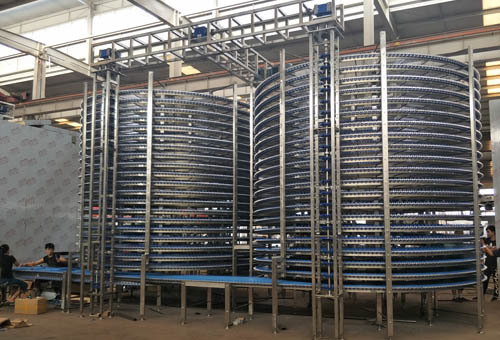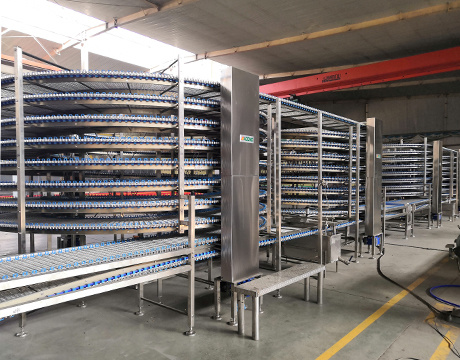Welcome To Know Our Products, We Can Offer You High Quality Products!
WhatsApp / WeChat : 008615127880005
Email : info@aocno.com
Spiral Cooling Towers: Unlocking Maximum Energy Efficiency for Industrial Cooling Systems
2025-06-13
1. Introduction to Spiral Cooling Towers
Spiral cooling towers are revolutionizing the landscape of industrial cooling systems. These advanced cooling solutions utilize a spiral design that optimizes airflow and enhances thermal exchange efficiency. As industries increasingly seek to minimize their energy consumption and reduce operational costs, the adoption of spiral cooling towers is becoming more prevalent. This article explores how these innovative systems work, their benefits, and their applications across different sectors.
2. How Spiral Cooling Towers Work
Spiral cooling towers capitalize on the principles of thermodynamics and fluid dynamics. The design features a spiral configuration that promotes efficient air and water flow, maximizing heat exchange. Here's a deeper look into their operational mechanisms:
2.1 Airflow Dynamics
The spiral structure allows air to enter at the base and ascend through the coil. This vertical movement of air facilitates effective heat removal from the water circulating within the tower. As air rises, it captures heat from the water, leading to a lower water temperature upon exit.
2.2 Water Distribution
Water is distributed evenly across the spiral coils, ensuring every part of the cooling surface is utilized. This uniform distribution minimizes the risk of hot spots and enhances cooling efficiency, enabling the system to operate at lower energy levels while maintaining optimal performance.
2.3 Heat Exchange Efficiency
The unique design of spiral cooling towers maximizes the surface area for heat exchange, which significantly improves the thermal efficiency of the cooling process. This results in reduced water temperature and minimized energy consumption, making them a preferred choice for many industrial applications.
3. Benefits of Using Spiral Cooling Towers
The adoption of spiral cooling towers in industrial applications brings several advantages:
3.1 Enhanced Energy Efficiency
One of the most significant benefits of spiral cooling towers is their energy efficiency. By maximizing the heat exchange process, these towers require less energy to achieve the desired cooling effect, leading to lower operational costs.
3.2 Space-Saving Design
The compact spiral design allows for a smaller footprint compared to traditional cooling towers. This is particularly beneficial for facilities with limited space, enabling industries to install effective cooling solutions without extensive modifications to existing infrastructure.
3.3 Reduced Water Consumption
Spiral cooling towers operate efficiently with lower water usage. This is crucial for industries in regions facing water scarcity, as it helps conserve this vital resource while still achieving effective cooling.
3.4 Lower Maintenance Costs
With fewer moving parts and a simplified design, spiral cooling towers require less maintenance compared to conventional systems. This translates to reduced downtime and lower overall maintenance expenses, adding to their cost-effectiveness.
4. Energy Efficiency: The Core Advantage
Energy efficiency is at the heart of the spiral cooling tower design. Various factors contribute to this advantage:
4.1 High Thermal Conductivity
Spiral cooling towers utilize materials with high thermal conductivity, enhancing the heat exchange process. This allows for greater energy savings as the towers perform efficiently even in high-demand scenarios.
4.2 Optimized Fan Operation
The design of spiral cooling towers allows for optimized fan placement and operation. By minimizing resistance and maximizing airflow, these systems can achieve significant energy savings, especially during peak operational hours.
4.3 Smart Control Systems
Modern spiral cooling towers often come equipped with intelligent control systems that monitor temperature and optimize performance in real time. This smart technology ensures that energy is used efficiently, reducing waste and enhancing overall system performance.
5. Applications of Spiral Cooling Towers in Various Industries
Spiral cooling towers find applications across a wide range of industries, including:
5.1 Manufacturing
In manufacturing environments, spiral cooling towers provide consistent cooling for equipment and processes. This ensures optimal operational conditions, improving overall production efficiency.
5.2 Power Generation
Power plants utilize spiral cooling towers to dissipate heat generated during electricity production. Their energy-efficient design plays a crucial role in enhancing the overall efficiency of power generation systems.
5.4 Chemical Processing
The chemical industry benefits from spiral cooling towers as they can effectively manage heat loads during various chemical reactions, maintaining safety and efficiency throughout processes.
5.4 HVAC Systems
In large commercial buildings, spiral cooling towers are integrated into HVAC systems to maintain comfortable indoor temperatures while optimizing energy consumption.
6. Maintenance Requirements and Best Practices
While spiral cooling towers are designed to be low-maintenance, implementing best practices can ensure longevity and efficiency:
6.1 Regular Inspections
Routine inspections help identify any potential issues before they escalate. Checking for signs of wear, corrosion, or debris buildup can prevent costly repairs and downtime.
6.2 Cleaning Protocols
Keeping the coils and water distribution system clean is vital for optimal performance. Regular cleaning reduces the risk of scaling and fouling, ensuring efficient heat exchange.
6.3 Monitoring Water Quality
Maintaining appropriate water quality is crucial for the longevity of spiral cooling towers. Implementing water treatment protocols prevents scaling and biological growth, contributing to improved efficiency.
7. The Future of Cooling Systems: Innovations and Trends
As industries evolve, so do cooling technologies. The future of spiral cooling towers looks promising with several trends emerging:
7.1 Integration of Renewable Energy
The incorporation of renewable energy sources, such as solar power, is expected to play a significant role in enhancing the sustainability of spiral cooling towers, further reducing their energy footprint.
7.2 Advanced Sensor Technology
The integration of advanced sensor technology will enable real-time monitoring and automated adjustments, optimizing performance and energy use even more efficiently.
7.3 Enhanced Materials
Research into advanced materials will further improve the efficiency and durability of spiral cooling towers, making them even more appealing for future industrial applications.
8. Conclusion
Spiral cooling towers represent a significant advancement in industrial cooling systems, offering enhanced energy efficiency, reduced water consumption, and lower maintenance costs. Their innovative design and ability to adapt to various industrial needs make them a preferred choice for businesses aiming to optimize their cooling processes. As industries continue to look for sustainable solutions, the role of spiral cooling towers will undoubtedly grow, paving the way for a more energy-efficient future.
9. Frequently Asked Questions
9.1 What are spiral cooling towers?
Spiral cooling towers are advanced cooling systems designed with a spiral configuration that optimizes airflow and heat exchange, enhancing cooling efficiency in industrial applications.
9.2 How do spiral cooling towers improve energy efficiency?
They improve energy efficiency by maximizing heat exchange, utilizing high thermal conductivity materials, optimizing fan operation, and employing smart control systems.
9.3 What industries commonly use spiral cooling towers?
Industries such as manufacturing, power generation, chemical processing, and HVAC systems commonly use spiral cooling towers for their cooling needs.
9.4 How often should spiral cooling towers be maintained?
Regular inspections and maintenance should be performed at least quarterly to ensure optimal performance, with cleaning protocols adjusted based on operational demands.
9.5 What is the future of spiral cooling towers?
The future includes advancements such as renewable energy integration, advanced sensor technology, and enhanced materials, all aiming to improve sustainability and efficiency further.
keywords:
RELEVANT INFORMATION
Optimizing Throughput: How Spiral Cooling Conveyors Revolutionize Production Lines
2025-06-23
Understanding Spiral Coolers: Efficient Solutions for Industrial Cooling Needs
2025-06-18
Spiral Cooling Towers: Unlocking Maximum Energy Efficiency for Industrial Cooling Systems
2025-06-13











